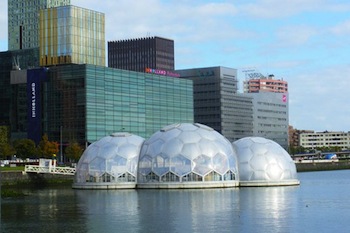Yesterday, we highlighted a futuristic underwater hotel that could be a harbinger of architectural design in a world coping with much higher sea levels.
The Dutch city of Rotterdam, which has committed to reducing carbon emissions by 50%, also has rising seas on its mind.
There, planners are looking at the potential of floating, solar-powered structures to address the challenge.
The Floating Pavilion prototype is a series of connected spheres currently moored at the city’s old harbor. That location was picked because of its relatively calm water and low waves, but the structure is designed to be easily towed and relocated.
Each translucent hemisphere is 40-feet tall and constructed from anti-corrosive ethylene tetrafluoroethylene (ETFE) plastic. The material is 100 times lighter than glass, enabling the entire structure to float. The total floor space inside is about the size of 40 tennis courts.

The spheres sit on top of "islands" made out of five layers of expanded polystyrene sheets ranging from 20 centimeters to 75 centimeters thick. Again, lightness is a major consideration – but the structure also has to be sturdy enough to accommodate groups of visitors without making them feel seasick.
Inside, the heating and air conditioning run on solar energy and systems powered by surface water. The electricity runs in zones, so it can be directed only where needed. The pavilion’s rest rooms use self-contained purification systems for the toilets. An auditorium in the building can accommodate up to 150 people.
As the water level rises, the floating pavilion will also rise, making it an example of climate-proof building, a technology for which demand will strongly grow in Rotterdam.
The Floating Pavilion, designed by Deltasync and PublicDomain Architects and constructed by Dura Vermeer, is a precursor to an entire community of floating homes envisioned by the Rotterdam Climate Initiative, the organization driving the city’s ambitious sustainability plan.
Rotterdam plans to build floating urban districts. The blueprint calls for 13,000 climate-proof houses in the Stadshavens area by 2040 – of which around 1,200 would be built on top of the water. People will live, shop, work and recreate on the water.
"Floating communities are an opportunity for new residential environments in Rotterdam," says Rotterdam Climate Initiative. "Especially for people who want to live in a special location and in a particular way in Rotterdam. People who are looking for tranquillity and space in an environment that is urban and abundant in water – will be very interested. For more creative entrepreneurs and small-scale production economy, floating constructions are an inspiring working environment."
For the first five years, the pavilion will serve as a center that demonstrates innovative and inspiring approaches to climate, energy and water.
While the prototype uses solar power, future designs will also rely on tidal energy, and cooling and heating from river water.
Once the industry in Rotterdam has gained expertise in this area, it will be able to market this knowledge to the rest of the world.
Learn more about Floating Pavilions:
